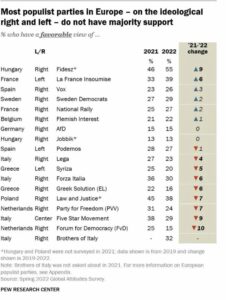Across Europe, political parties and formations dubbed as ‘populists’ have been winning larger shares of the vote in recent parliamentary elections, according to a Pew Research Center analysis based on data drawn primarily from Parlgov, a transnational political intelligence aggregator.
This Center defines populists based on three academic metrics and classifies them as right-wing or left-wing based on expert assessments of their ideology.

In Italy this year, for example, about four in ten voters voted for one of the three major right-wing populist parties: Brothers of Italy, Forza Italia, and Lega, up from about a third who did the same in 2018 and about three in ten in 2013. On the other hand, Five Stars, a centrist populist party, has seen its vote share roughly halve since 2018 when it governed as part of a populist coalition with the League.
also read
Greek major opposition party SYRIZA also appears in the list presented at the Pew Research Center, as does the Hellenic Solution along with the “top” on the list, Hungary’s Fidesz, Spain’s Voch, the Sweden Democrats, the League, Podemos, and other European parties.
Ask me anything
Explore related questions





